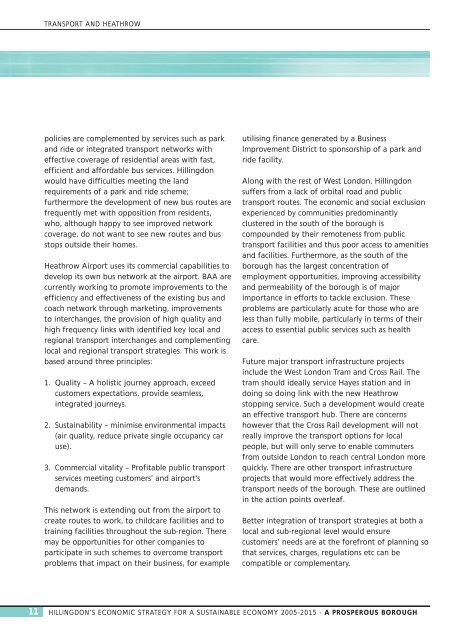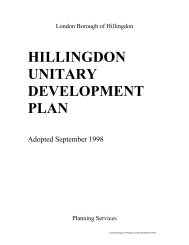Economic development strategy - London Borough of Hillingdon
Economic development strategy - London Borough of Hillingdon
Economic development strategy - London Borough of Hillingdon
You also want an ePaper? Increase the reach of your titles
YUMPU automatically turns print PDFs into web optimized ePapers that Google loves.
TRANSPORT AND HEATHROW<br />
policies are complemented by services such as park<br />
and ride or integrated transport networks with<br />
effective coverage <strong>of</strong> residential areas with fast,<br />
efficient and affordable bus services. <strong>Hillingdon</strong><br />
would have difficulties meeting the land<br />
requirements <strong>of</strong> a park and ride scheme;<br />
furthermore the <strong>development</strong> <strong>of</strong> new bus routes are<br />
frequently met with opposition from residents,<br />
who, although happy to see improved network<br />
coverage, do not want to see new routes and bus<br />
stops outside their homes.<br />
Heathrow Airport uses its commercial capabilities to<br />
develop its own bus network at the airport. BAA are<br />
currently working to promote improvements to the<br />
efficiency and effectiveness <strong>of</strong> the existing bus and<br />
coach network through marketing, improvements<br />
to interchanges, the provision <strong>of</strong> high quality and<br />
high frequency links with identified key local and<br />
regional transport interchanges and complementing<br />
local and regional transport strategies. This work is<br />
based around three principles:<br />
1. Quality – A holistic journey approach, exceed<br />
customers expectations, provide seamless,<br />
integrated journeys.<br />
2. Sustainability – minimise environmental impacts<br />
(air quality, reduce private single occupancy car<br />
use).<br />
3. Commercial vitality – Pr<strong>of</strong>itable public transport<br />
services meeting customers’ and airport’s<br />
demands.<br />
This network is extending out from the airport to<br />
create routes to work, to childcare facilities and to<br />
training facilities throughout the sub-region. There<br />
may be opportunities for other companies to<br />
participate in such schemes to overcome transport<br />
problems that impact on their business, for example<br />
utilising finance generated by a Business<br />
Improvement District to sponsorship <strong>of</strong> a park and<br />
ride facility.<br />
Along with the rest <strong>of</strong> West <strong>London</strong>, <strong>Hillingdon</strong><br />
suffers from a lack <strong>of</strong> orbital road and public<br />
transport routes. The economic and social exclusion<br />
experienced by communities predominantly<br />
clustered in the south <strong>of</strong> the borough is<br />
compounded by their remoteness from public<br />
transport facilities and thus poor access to amenities<br />
and facilities. Furthermore, as the south <strong>of</strong> the<br />
borough has the largest concentration <strong>of</strong><br />
employment opportunities, improving accessibility<br />
and permeability <strong>of</strong> the borough is <strong>of</strong> major<br />
importance in efforts to tackle exclusion. These<br />
problems are particularly acute for those who are<br />
less than fully mobile, particularly in terms <strong>of</strong> their<br />
access to essential public services such as health<br />
care.<br />
Future major transport infrastructure projects<br />
include the West <strong>London</strong> Tram and Cross Rail. The<br />
tram should ideally service Hayes station and in<br />
doing so doing link with the new Heathrow<br />
stopping service. Such a <strong>development</strong> would create<br />
an effective transport hub. There are concerns<br />
however that the Cross Rail <strong>development</strong> will not<br />
really improve the transport options for local<br />
people, but will only serve to enable commuters<br />
from outside <strong>London</strong> to reach central <strong>London</strong> more<br />
quickly. There are other transport infrastructure<br />
projects that would more effectively address the<br />
transport needs <strong>of</strong> the borough. These are outlined<br />
in the action points overleaf.<br />
Better integration <strong>of</strong> transport strategies at both a<br />
local and sub-regional level would ensure<br />
customers’ needs are at the forefront <strong>of</strong> planning so<br />
that services, charges, regulations etc can be<br />
compatible or complementary.<br />
11 HILLINGDON’S ECONOMIC STRATEGY FOR A SUSTAINABLE ECONOMY 2005-2015 - A PROSPEROUS BOROUGH

















